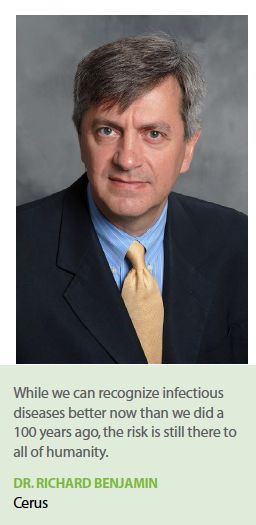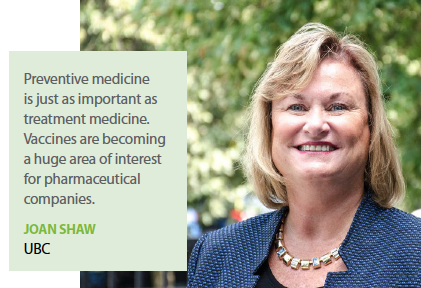Epidemics of infectious diseases are a real and dangerous threat. Nowhere in the world have infectious diseases been addressed adequately to become a small portion of illness and death.
The Ebola and Zika public health emergencies have brought to light that we are unprepared to detect, prevent, and treat pandemic infections. These outbreaks cost thousands of lives — Ebola alone has claimed more than 11,000 lives — and billions of dollars.
The devastating birth defects that Zika cause will continue to have an impact on healthcare systems for many years to come.
 But these aren’t the only infections that have the potential to cause pandemics. Experts says pneumonia, tuberculosis, parasitic infections, and influenza infections have the potential to become threats if not addressed. The Centers for Disease Control and Prevention (CDC) ranks H7N9 as the flu strain with the greatest potential to cause a pandemic.
But these aren’t the only infections that have the potential to cause pandemics. Experts says pneumonia, tuberculosis, parasitic infections, and influenza infections have the potential to become threats if not addressed. The Centers for Disease Control and Prevention (CDC) ranks H7N9 as the flu strain with the greatest potential to cause a pandemic.
A 2014 study published in the Journal of the Royal Society Interface found that 65% of the diseases making up 56% of all outbreaks, were infections that were transmittable to humans by animals, insects, and other vectors. These include Ebola, HIV, bubonic plague, and Lyme disease. Smallpox is still the only human disease to have been eradicated by vaccination, the last case having been reported in Somalia in 1977.
Managing infectious disease has become a priority for public health agencies, and science and health experts are weighing in about new pandemics to come. In third world countries, a lack of healthcare infrastructure makes it hard to control infections. In the United States and other developed countries, resistant strains and hospital infections remain a concern.
In fact, a May 2017 article in Time magazine says infectious disease is the next global security risk. This may seem alarmist, but industry experts we spoke to agree the risks from infectious disease shouldn’t be underestimated.
“It’s not an overstatement to say that it’s a global security risk," says Bob Holloway, senior VP, marketing strategy, Cadient.
“Thankfully, the reality is that superbugs are still a pretty rare occurrence. Resistance is coming not just for superbugs, but also for infections that are common. The more common bacteria that cause pneumonia, for example, are also becoming resistant. We are getting to a point where current drugs won’t be able to effectively treat these infections. And this is why we talk about a global security risk."
The global environment is so interconnected now, says Steve Gelone, Pharm.D., chief scientific officer and head of business development at Nabriva Therapeutics, a clinical-stage biopharmaceutical company developing novel antibiotics to treat serious infections.
“Global travel has accelerated the propagation of resistance," he says.
Richard Benjamin, MBChB, Ph.D., chief medical officer, Cerus, says infections are a constant threat.
“While we can recognize infectious diseases better now than we did 100 years ago, the risk is still there to all of humanity," he says. “Infectious diseases will continue to surprise us. Things we don’t think are a problem and spread can turn into a big problem very quickly to become a pandemic. There are an infinite number of threats both new and old."
Cerus is a biomedical products company that manufactures a system to reduce the risk of transfusion-transmitted infections that may be present in donated blood.
The global impact of infection from a loss of life and from an economic perspective is tremendous, says Tim Hoctor, VP, life science solutions services, Elsevier’s R&D Solutions.
 Infectious disease epidemics cost the world $60 billion each year. The 2003 SARS epidemic, for example, killed fewer than 800 people, but cost the global economy $54 billion. The World Bank estimates that the toll from a severe flu pandemic could hit $4 trillion.
Infectious disease epidemics cost the world $60 billion each year. The 2003 SARS epidemic, for example, killed fewer than 800 people, but cost the global economy $54 billion. The World Bank estimates that the toll from a severe flu pandemic could hit $4 trillion.
Despite advanced treatments, worldwide, the number of deaths caused by pathogens and parasites is falling slowly. In 1990, an estimated 16 million people died from infections. In 2010, the number of deaths had fallen to 15 million, a decline of 1% per year. And the World Health Organization (WHO) forecasts 13 million deaths attributed to these diseases in 2050.
Stopping pandemics is going to mean that we provide the best healthcare available globally, says Joan Shaw, VP, global clinical development and operations, UBC.
“We need to be able to train doctors and other medical professionals as much as possible about a therapy, its administration, timeframes for effective immunization, adverse event reporting, and safe storage, among other factors, including a region’s environmental, social, and political landscape," she says.
Part of the problem, Dr. Gelone says, is the result of pharma walking away from anti-infective development in the early 2000s because they didn’t see it as a commercially attractive place to invest their money.
“Because the research of new anti-infectives slowed down, bacteria continue to do what they do," he says. “There needs to be a long-term commitment to anti-infective research."
Dr. Gelone says we need a sustainable antibiotic pipeline with continued investment for about five to 10 years.
“We’re trying to position ourselves for tomorrow’s problem," he says. “Epidemiologic research both at the government and the private levels can give insights into where we should be investing today."
Nabriva is developing its lead product candidate, lefamulin, to be the first pleuromutilin antibiotic available for systemic administration in humans.
The company’s lead product candidate, lefamulin in both oral and IV formulations, is being studied in two global, registrational Phase III clinical trials for the treatment of moderate-to-severe community-acquired bacterial pneumonia (CABP).
The company also is conducting Phase II trials in acute bacterial skin and skin structure infections, in addition to those hospital-acquired bacterial pneumonia, bone and joint infections, prosthetic joint infections and sexually transmitted diseases, including drug-resistant Neisseria gonorrhea.
Global efforts to advance research for vaccines are growing. For example, in January 2017, a global coalition was launched to create new vaccines for emerging infectious diseases. With an initial investment of $460 million from the governments of Germany, Japan, and Norway, plus the Bill & Melinda Gates Foundation and the Wellcome Trust, the Coalition for Epidemic Preparedness Innovations (CEPI) will seek to develop safe and effective vaccines against known infectious disease threats.
CEPI will initially target the MERS-CoV, Lassa, and Nipah viruses, which have known potential to cause serious epidemics. CEPI will also look at potential support for vaccines against multiple strains of the Ebola and Marburg viruses, and Zika.
 In the United States, the Food and Drug Administration understands the need for incentives. The Generating Antibiotic Incentives Now (GAIN) Act was passed as part of the FDA’s Safety and Innovation Act of 2012. Under this Act, drugs that receive qualified infectious disease product (QIPD) designation are eligible for several incentives, including fast-track designation, priority review designation, and an additional five years of market exclusivity if approved.
In the United States, the Food and Drug Administration understands the need for incentives. The Generating Antibiotic Incentives Now (GAIN) Act was passed as part of the FDA’s Safety and Innovation Act of 2012. Under this Act, drugs that receive qualified infectious disease product (QIPD) designation are eligible for several incentives, including fast-track designation, priority review designation, and an additional five years of market exclusivity if approved.
According to the General Accounting Office, the FDA has approved more than 100 requests for QIPD status between 2012 and 2015, about 90% of the total requests made, and has so far approved six of those drugs.
“The GAIN Act was put in place to facilitate the development of treatments for infectious disease," says Patrick Smith, Pharm.D., chief scientific officer, Certara Strategic Consulting Service. “This created a voucher system that allows a company priority review, which speeds up the review process by six months. The voucher can be traded and used for any drug in the portfolio. One of these vouchers was sold for $350 million."
Analytics to Predict Infection Risks
Experts agree surveillance is critical for predicting where and what types of pathogens are likely to spread.
There are emerging technologies that can help with the learning from the spread of malaria and other diseases, says Nick Lynch of The Pistoia Alliance. He points to one of the winners of the Alliance’s innovation competition in 2016: xRapid, which has the ability to diagnose malaria quickly from a blood sample. Since its creation in 2014, xRapid has expanded quickly by selling medical diagnostic tests all over the world.
“Taking learnings from other infectious or other diseases can perhaps help with the ability to build rapid applications that can at least determine if someone is infected," Mr. Lynch says.
Local providers are beginning to understand that if they look at the health information technology they have, they are capturing trends in antimicrobial resistance, says Dr. Steve Arlington, president, The Pistoia Alliance.
“If providers can bring their health information technology together, they can start to spot early on antimicrobial resistance patterns on both a personal patient level and a local hospital level," he says. “When they share data with other hospitals and outside of their own countries, multifaceted patterns are beginning to emerge."
Efforts are being made at the global level to improve surveillance and prediction of pandemics. Advances are being made in mathematical modeling, allowing a better understanding and prediction of how pandemics spread and what interventions can be made to minimize the spread.
“These mathematical models include entire populations and factor in how people move around," Dr. Smith says. “With these types of models we can test various interventions to determine which would be the most effective under specific pandemic conditions. In the past five years, these models have become much more sophisticated with advances in computing power and modeling techniques."
One such effort is the U.S. Agency for International Development (USAID), as part of the Emerging Pandemic Threats (EPT-2) program. The PREDICT project, launched in 2009, is enabling global surveillance for pathogens such as coronaviruses, the family to which SARS and MERS belong; paramyxoviruses, such as Nipah virus; influenza viruses; and filoviruses, such as the Ebola virus.
PREDICT uses modeling and analytic approaches to guide surveillance and help countries develop disease control and prevention strategies. The project creates fine-scale hotspot maps, combining data on land use, socioeconomic and agricultural changes with  surveys of human behavior, market value chains, and livestock production to identify who might be at risk. The modeling can also provide information about which pathogens are most likely to become pandemic.
surveys of human behavior, market value chains, and livestock production to identify who might be at risk. The modeling can also provide information about which pathogens are most likely to become pandemic.
“The critical thing is for us to identify and understand what’s happening and then apply the science that we have," Mr. Hoctor says. “This is where big data comes in. We are developing computational capabilities to look at what is happening in a body when affected by a disease and when being treated therapeutically; we then can see not just which genes are being triggered but how they’re being triggered, when they’re being triggered, and in what sequence."
Mr. Hoctor says there is a need for better tools that capitalize on machine learning and artificial intelligence for more effective prediction of a potential pandemic before it arises.
“We don’t necessarily need better data," he says. “There are tons and tons of data; we just need to know how to interpret the information and then how to process it."
Addressing Antimicrobial Resistance
Antimicrobial resistance is a natural process by which bacteria and other microbes develop resistance to the drugs commonly used to treat infections, including antibiotics, antivirals, antiparasitics, and antifungals. In 2016, an independent review team commissioned by the U.K. government and made up of experts from both the public and private sectors determined that, without effective global action, the rise of resistance could claim 10 million lives globally each year by 2050.
“We’re seeing more and more resistant bacteria, especially in the hospital setting where we do not have available drugs and it’s becoming more and more of a problem," Dr. Smith says.
Bacteria evolve faster than our ability to track these changes.
“We in the research community can’t keep up," Mr. Hoctor says. “Whether SARS or Zika or a novel infection, we don’t have adequate treatments ready for new diseases. And by the time these infections become so prevalent as to come to the attention of WHO and CDC, they are already on the way to becoming serious. The way in which they travel and the way in which they spread mean that they are major issues before we even know whether or not we have something to treat them."
Antimicrobial resistance now is seen as a worldwide health threat, Dr. Arlington says.
“While there’s a lot of work going on around producing novel antibiotics, there are now quite a few people who are investigating ways in which health information and health information technology can help us promote antimicrobial stewardship," he says.
“Health information technology has the potential to support antimicrobial stewardship by picking up and seeing trends that previously we wouldn’t see by using electronic health records and data within hospitals and between hospitals and health areas."
Pharma companies have to think scientifically different, Mr. Holloway says.
“A lot of the research that’s going on right now is around derivatives of existing drugs or existing mechanisms of action," he says. “There has been a bit of an improvement, but ultimately super bugs can make an adjustment to these incremental changes. There aren’t a lot of new mechanisms that are being researched."
Mr. Holloway points out that there are a couple of market forces that impact antibacterial research. Often, he says, physicians will use new antibacterial drugs only after other options have failed as a way to help preserve therapies for resistant strains. The resulting low sales make new antibiotics a hard business case to make. Secondly, a large portion of antibiotic options are generic, which creates significant inertia with physicians in moving to new therapies, even when those therapies are significant.
Dr. Smith agrees, with regard to bacterial infections, the economics are completely broken and the system has to change.
“There is very little financial incentive for companies to bring new antibiotics to market," he says. “The tendency when a new drug is brought to market is to protect that drug because the organisms will always become resistant to it. So drug companies sell very little and can’t make enough money to justify the cost of developing these products."
This is starting to change. Through collaborations, the industry is addressing the spread of antibiotic-resistant bacteria. In September 2016, leading biopharmaceutical companies signed on for an “industry roadmap," a comprehensive plan of action to deliver by 2020 drugs for antimicrobial resistance.
In March 2017, the Combating Antibiotic-Resistant Bacteria Biopharmaceutical Accelerator (CARB-X) collaboration announced it was initially investing $24 million and an additional $24 million in milestone-based additional payments over three years to help 11 biotech companies and research teams in the United States and United Kingdom to accelerate the development of new antibacterials and diagnostics.
This is the first phase of CARB-X, launched July 28, 2016. The collaboration aims to invest up to $450 million over five years. It was launched by the U.S. Department of Health and Human Services, Biomedical Advanced Research and Development Authority and the National Institute of Allergy and Infectious Diseases.(PV)

















